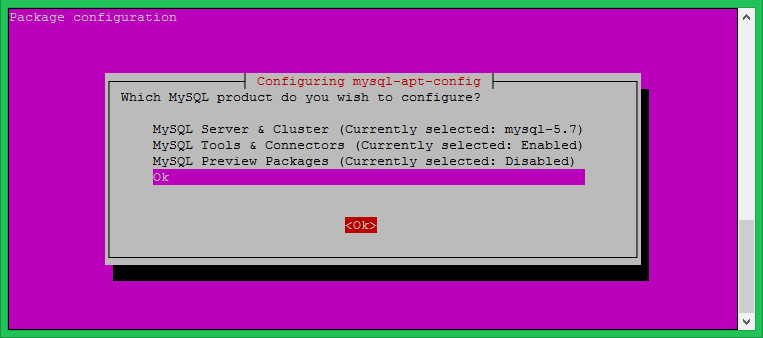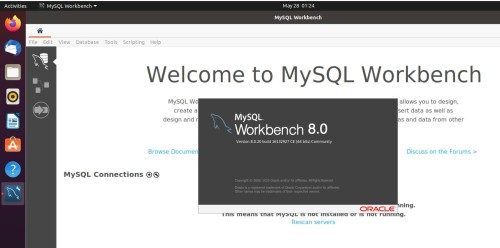

How to Install MariaDB on Ubuntu 18.04/16.

How to Install MySQL 5.7 on Ubuntu 20.04 LTS In this article, We have performed ,How to Install MySQL 5.7 on Ubuntu 18.04 LTS System, creating new user and enabled remote access. Sudo systemctl restart rvice #8: Start/Restart/Stop MySQL Server Using Command Lineīelow are commands to start/restart/stop MySQL 5.7 on Ubuntu 16.04 sudo systemctl start rvice Open the /etc/mysql//mysqld.cnf file sudo vim /etc/mysql//mysqld.cnfīelow the section find the Line, To enable remote connections of MySQL Server, we have to change bind-address in MySQL configuration file. To take effect reload the privileges using below command, mysql> FLUSH PRIVILEGES #7: How to Enable MySQL Remote Access in Ubuntuīy default, In MySQL database server remote access is disabled for security reason. Mysql> GRANT ALL PRIVILEGES ON *.* TO WITH GRANT OPTION * TO you want to allow “fosstechnix” user to give privileges to other user. If you want to assign privileges to specific database replace ”. Next, assign the privileges to database with below command, here i am assigning all databases privileges to user fosstechnix, #6: Create MySQL Remote Userįirst, Login to MySQL Server with root user using command line, Below is command is to create user, here i am creating user “ fosstechnix“. Now, We have successfully covered install MySQL 5.7 on Ubuntu 18.04 LTS. Type '\c' to clear the current input statement.

Other names may be trademarks of their respective Oracle is a registered trademark of Oracle Corporation and/or itsĪffiliates. Server version: 5.7.29 MySQL Community Server (GPL)Ĭopyright (c) 2000, 2020, Oracle and/or its affiliates.
MYSQL DOWNLOAD UBUNTU PASSWORD
Now, Login to MySQL 5.7 Server using below command and use password to login entered during installation. Reload privilege tables now? (Press y|Y for Yes, any other key for No) : y Remove test database and access to it? (Press y|Y for Yes, any other key for No) : y Remove anonymous users? (Press y|Y for Yes, any other key for No) : yĭisallow root login remotely? (Press y|Y for Yes, any other key for No) : y Press y|Y for Yes, any other key for No: NoĬhange the password for root ? ((Press y|Y for Yes, any other key for No) : No Would you like to setup VALIDATE PASSWORD plugin? Run the below script on command prompt, asks below options. MySQL Server comes with a script mysql_secure_installation this can do multiple security related operations, Now, Installation process will prompt default password for root user and again same password. Install MySQL 5.7 using below commands, sudo apt-get install mysql-server
MYSQL DOWNLOAD UBUNTU UPDATE
Update apt repository sudo apt-get update #3: Install MySQL 5.7 on Ubuntu 18.04 LTS When we run above command like below prompt will open, By default it shows MySQL 8.0Ĭlick on First Option and Select MySQL 5.7 and Press Tab Button Then, below command is to install above downloaded apt repository, sudo dpkg -i mysql-apt-config_0.8.15-1_all.deb This will install the default version, often there are packages for other MySQL versions, e.g. 10:43:27 (2.71 MB/s) - ‘mysql-apt-config_0.8.15-1_all.deb’ saved mysqldump is part of the package mysql-client and can be installed with: sudo apt-get install mysql-client. Step 3: Launch the MySQL workbench on your Ubuntu system. mysql - workbench - community8.0.20. Confirm that showing MySQL 5.7 on First option and Click on OK. Step 2: Once the download is completed, now navigate into ‘Downloads’ and issue the following command to install the deb packages with all its dependencies. By default it shows MySQL 8.0, Click on First option. So,if we want to add/install latest repositories then we have to add/install package repositories.īelow are commands to add/download latest MySQL APT repository using command line, sudo wget

Ubuntu comes with default package repositories. MySQL has client/Server architecture, supports InnoDB storage engine,can be installed on various operating system like Ubuntu,Debian,CentOS,Windows.,etc. It is widely used with web server like apache2,Nginx,IIS,etc. MySQL is the world’s most popular open source relational database management system. #8: Start/Restart/Stop MySQL Server Using Command Line.#7: How to Enable MySQL Remote Access in Ubuntu.


 0 kommentar(er)
0 kommentar(er)
